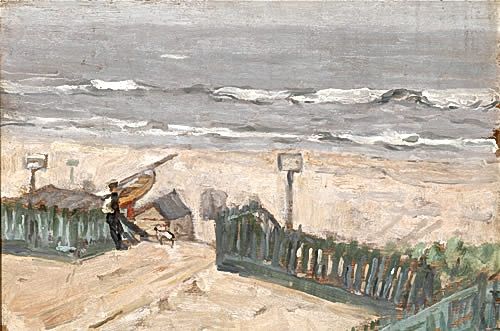
Bathing huts with fishermanand dog, circa 1900
Framed (ref: 245)
No. 477 on reverse
Oil on panel, 6 1/4 x 8 3/4 in. (15.8 x 22.2 cm.)

No. 477 on reverse
Oil on panel, 6 1/4 x 8 3/4 in. (15.8 x 22.2 cm.)
Provenance: Peter Cochran; The Fine Art Society
Exhibited: Arthur Studd, (solo exhibition), Alpine Club, June 1911
It’s
commonly believed that Paul Gauguin worked in isolation in Tahiti,
living in self-imposed exile from France and far from the reach of the
European avant-garde. But from 1897 to 1898 Gauguin was joined in Tahiti
by a British painter, Arthur Haythorne Studd (1863 – 1919). It was
Studd’s wish, as he declared in a letter to his friend James McNeil
Whistler (dated 22 June, 1897), to establish a ‘Studio of the South
Seas’, and his work from Tahiti includes the View from Gauguin’s House,
of 1898. This paper will compare Studd’s paintings to Gauguin’s
treatment of the Tahitian subject, and examine how these artists
imagined the Islands for a modern European audience. It will tease out
the various influences on Studd’s Tahitian work, from his Slade School
and Academie Julian training, to his ties to Whistler, and an artistic
circle which included the New English Art Club, French painters Degas,
Picard, and Puvis de Chavannes, and Australian Charles Conder.
Notwithstanding the influence of contemporary artists, Studd’s paintings
will also be understood in the context of colonial modernity and the
extent to which modern political, economic and cultural agendas may have
impacted his treatment of the Tahitian subject. Though the focus of
this paper is on Studd’s contact with Gauguin and modernist
re-imaginings of the Pacific Islands, it will also begin a biography of
this important British painter and collector, whose story remains to be
told.